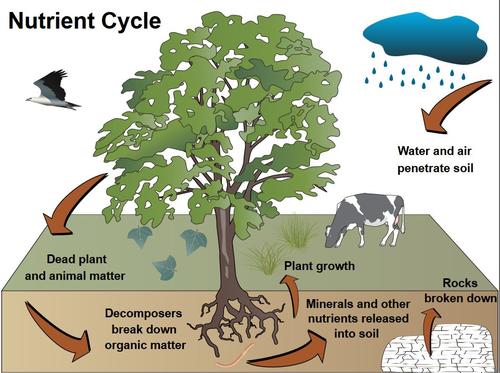Nutrient cycle
Nutrients are chemical elements all plants and animals require for growth. On earth exists a constant and natural cycle in which these elements are incorporated during organism growth and degraded when organisms dies. The largest amounts of nutrients used are the non-mineral elements, i.e. carbon (C), hydrogen (H) and oxygen (O). These elements are mainly taken up as carbon dioxide (CO2) from the air and water (H2O) by the roots. However, these are not sufficient for life to exist. Further elements are important to fuel life on earth: Nitrogen (N) and Phosphorus (P), Potassium (K) as well as Calcium (Ca) and Magnesium (Mg) are highly important, in particular for plant growth and agriculture. (Jönsson et al. 2004)
Plants take up nutrients available in the soil layer. These nutrients are transferred to humans or animals by consuming and digesting plants and released back into the environment as excrements or organic debris (e.g. dead organism remains such as leaves). Microorganisms break down organic debris in the soil and make nutrients available in their mineral form, which enables plants to take up and hence, reuse them. Currently, large parts of humankind influence the nutrient cycle in the way that we remove nutrients from the terrestrial and discharge them into aquatic environments. On the one hand, this leads to soil depletion in terrestrial environments and on the other hand, an overabundance of nutrients and pollution of water sources. (Conradin 2012b)
In aquatic systems, nitrogen and phosphorus are the two nutrients that primarily control the growth of aquatic plants, algae and bacteria. Nitrogen and phosphorus are considered to be the primary drivers of eutrophication of aquatic ecosystems, where increased nutrient concentrations lead to increased primary productivity. Some systems are naturally eutrophic, whereas others became eutrophic because of human activity, such as runoff from agricultural areas and discharge of municipal waste into rivers and lakes. (UNEP 2008)
